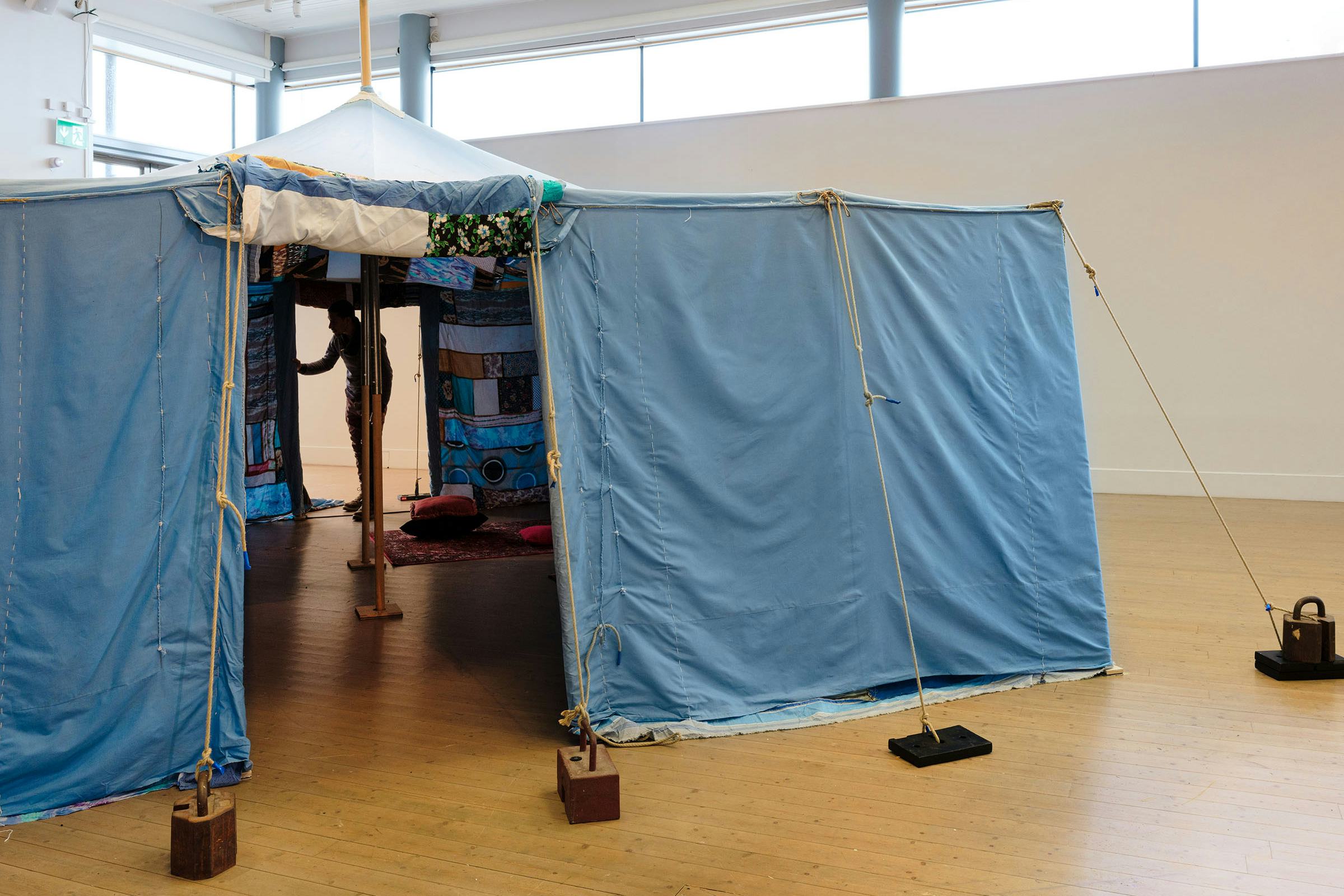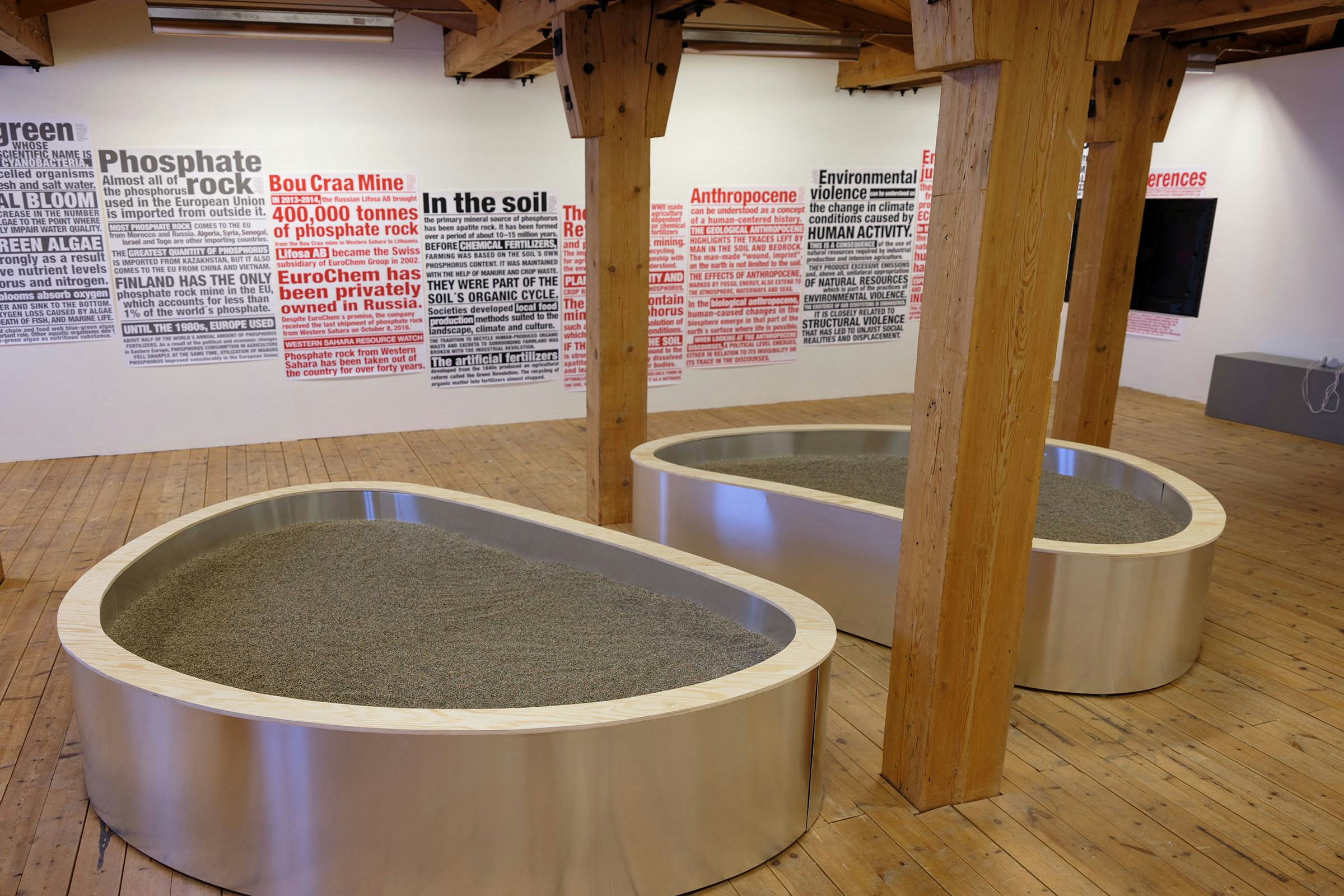LB°24 — Participants
PhosFATE is a collaborative project by Mohamed Sleiman Labat (1986, Sahrawi Refugee Camp/ Tindouf, Algeria) and Pekka Niskanen (1961, Mikkelin mlk, Finland).
PhosFATE, 2023 – ongoing
The project PhosFATE delves into the impacts of phosphate on two disparate landscapes: the Baltic region and the Sahrawi Refugee camps in the Hamada Desert. Phosphate is a compound that includes phosphorus, a vital element found in nature which plays a crucial role in various biological processes and is a key component in fertilisers and other essential products. The interplay of phosphate mining and the Western Sahara War forced the Sahrawi, once pastoralist nomads in the Western Sahara Desert, to seek refuge in Algeria. Furthermore, phosphate's far-reaching consequences extend to the Baltic Sea, where fertilisers derived from phosphate rock sourced in Western Sahara have contributed to the sea’s pollution and the demise of marine life over half a century.
Phosphorus is shaping Norrbotten and underlies the construction of a circular industrial park in Luleå, for the extraction and processing of phosphorus and other by-products of iron ore mining from Kiruna and Gällivare/Malmberget. These processes are critical for achieving European self-sufficiency in phosphorus and rare earth metals essential for sustainable agriculture and the “green transition”. This is crucial at a time when the EU heavily depends on phosphorus imports, and Russia contributes significantly to phosphorus production. However, a side-effect of such “green-industries” is the exploitation of a region already grappling with the first-hand consequences of climate breakdown and the segregation of communities such as the Sámi – echoing the displacement of the Sahrawi.
PhosFATE unfolds the story of this mineral, revealing the interconnectedness of ecological practices, social change through community efforts, world politics and economics, the very food on our tables, and the everyday stories we tell.
On view in Konsthallen Kulturens Hus, Luleå
Community Art Tent, 2019 – ongoing
Canvas fabric, Sahrawi women dresses "Melhfa". 600 x 600 cm.
Tent made in collaboration with Fatimatu Said, Sherifa Saleh, Tumana Buzaid, Mela Said, Galia Mustafa, Azuha Hama, Nana Said and others.
The tent has been the primary dwelling for the Sahrawi, it provided an ideal structure for their past nomadic lifestyle, and currently, as refugees, it functions both as a space for communal living and shared meals, and as a crucial refuge in the harsh desert environment. Sleiman Labat, native to this community and still residing in one such tent, collaborated with women in the refugee camps who designed and hand-sewed the tent by gathering everyday clothes and stories that held them.
For the Sahrawi, the tent is a symbol of communal bonds and shared identity. In Hassaniya, their oral language, the term "tent" carries a dual meaning, also signifying the concept of "family." This dwelling is built with four entrances facing different directions that offer protection from desert sandstorms, which can approach from any angle, and express the Sahrawi’s profound hospitality, welcoming anyone coming from different directions.
The exhibited tent provides an internal space for immersing oneself in Sahrawi narratives. Both during the biennial’s opening and concluding days, Sleiman Labat and Niskanen utilise this space to share Sahrawi rituals and stories and their ongoing artistic research, encouraging dialogue and collaborative learning. In the biennial’s final days, the tent moves outside the exhibition space and occupies a public space in Luleå, embodying its nomadic essence and characteristic hospitality, engaging with broader segments of the local community.
On view in Konsthallen Kulturens Hus, Luleå, and Havremagasinet, Boden
DESERT PHOSfate, 2023/24
4 channel video installation (2 videos presented in both Luleå Konsthall and Havremagasinet, Boden), 58 min total. Variable dimensions.
DESERT PHOSfate is an experimental documentary by Sleiman Labat, co-produced by Niskanen, which documents life in the Sahrawi Refugee camps in the Hamada Desert, and registers the stories and narratives of this community.
The Sahrawi have had ways to relate to time and place through intergenerational oral traditions which pass on unique worldviews and important knowledge on the landscape, geography, species and other crucial experiences for navigating the desert. But the process of becoming refugees and subsequently sedentary has led to the loss of many of their material and immaterial traditions. DESERT PHOSfate not only serves as a documentation of the realities faced by the Sahrawi but also stands as a testament to the resilience and complexity of their narratives amidst socio-political and ecological challenges, colonial legacies, and the erosion of indigenous worldviews.
The testimonies in the film are told from the Sahrawis’ perspective, and weave the processes triggered by phosphate with multi-layered narrations about connections to land, sand particles, plants, human and mineral displacement. The structure of the video-installation, exhibited in Luleå Konsthall and Havremagasinet, explores the poetics of juxtaposition and non-linearity in which the Sahrawi narrate their stories and share their knowledge.
On view in Havremagasinet, Boden:
PHOSfate Community Garden, 2023 – ongoing
Sand, plywood, wood, aluminium, plastic, seeds and water. Variable dimensions.
Pekka Niskanen, Baltic Sea and Phosphorus, 2023
12 posters, digital prints on 90 g matte paper, 134 x 94 cm each.
The Sahrawi, originally nomads, thrived on a pastoralist diet rying on local environmental resources. However, displacement and subsequent sedentarization in Algerian refugee camps led to a dietary shift, heavily dependent on food from international aid. This transition resulted in poor diet diversification and widespread malnutrition, highlighting the pressing need for local solutions to access fresh food.
Despite lacking an agricultural background, the Sahrawi developed site-specific knowledge of farming without processed phosphorus. Small-scale family gardens, now numbering over a thousand, emerged around 2002, reshaping the community's relationship with sand and food. Key figures, including Sahrawi agricultural engineers and farmers, continually research and develop gardening practices, blending ethnobiological and desert knowledge with Western permaculture methods. Evolving techniques include local fertiliser production, shading and irrigation systems, as well as the usage of an important new garden model, the Sandoponic garden, which uses sand as a medium to plant vegetables and is designed to preserve as much water and nutrients as possible in the harsh desert conditions.
With the exhibited Sandoponic garden, Sleiman Labat and Niskanen experiment with growing diverse vegetables parallel to family gardens in the Hamada Desert. Seeds collected globally by the artists are preserved in the Almasar Library, establishing the first seed bank in Sahrawi camps. Collaborating with the library, the artists actively distribute seeds to family gardens. In Boden, the significance of the Sandoponic garden deepens, as the town, together with Luleå, is part of a hub for phosphate extraction and for the production of green ammonia and fertilisers, which could help achieve Sweden’s self-sufficiency in these goods.
Works’ credits, contributors and funders
DESERT PHOSfate
Production: Motif Art Studio
Film Director: Mohamed Sleiman Labat
Co-producer: Pekka Niskanen
Editing Subtitles: Mohamed Sleiman Labat
Voiceover: Sulaiman Labat Abd
Drum Artist: Mbarka Eggyn
Sound Designer: Juuso Oksala
English Subtitles: Mohamed Sleiman Labat
Music Recording: Saluan Radio Studio, Samara Camp
Main Cast: Taleb Brahim, Menaha Mahmud, Yaugiha Mohamed, Sulaiman Labat Abd, Fatimatu Said Ramdan, Mohamed Salem Mohamed Ali
The artists used archival materials from these Sahrawi sources
Algaada Centre for Small Scale Farming and Agricultural Research, Samara Camp
Nomad Garden, Samara Camp
Saluan Radio Studio, Samara Camp
DESERT PHOSfate is part of PHOSfate Artistic Research project together with Pekka Niskanen.
It received funding from Kone Foundation, Arts Promotion Centre Finland, Oskar Öflunds Stiftelse.
PHOSfate Community Garden
The project is supported by: Kone Foundation, the Arts Promotion Centre Finland, Oskar Öflunds Stiftelse, Jenny and Antti Wihuri Foundation, Frame Contemporary Art Finland and Kulturfonden för Sverige och Finland.
The artists wish to thank Viivi Koljonen and Mirek Träskman.
About Mohammed Sleiman Labat & Pekka Niskanen
Mohammed Sleiman Labat is a visual artist and poet. He is the founder of MOTIF arts studio in Tindouf refugee camp, in the Hamda desert. Established in 2017, the studio is where the artist experiments with discarded materials found in the camp to make meaningful visual pieces as well as facilitates cross-generational learning through the arts, particularly focusing on the preservation of traditional storytelling and oral history. It is now a hub for artistic practice in the remote desert, whilst serving as a space for Saharawi youth to gain skills and explore their creative potential.
Pekka Niskanen is a media artist, video- and filmmaker. He studied visual communication in the University of Art and Design in Helsinki and Media Art in Rijksakademie van Beeldende Kunsten in Amsterdam. He completed his dissertation at the Finnish Academy of Fine Arts in 2014. Previous exhibitions include the White Box Gallery, New York (2004) and Galleria Hippolyte, Helsinki (2014). His works are represented in collections such as the Helsinki Art Museum, Museum of Contemporary Art Kiasma. Niskanen has also visualized experimental theatre in Finland and realized the set design and costumes for Verdi’s Rigoletto in Gothenburg’s Opera, Sweden (2005).
Supported by
Suomen Kulttuurirahasto (the Finnish Culture Fund)


